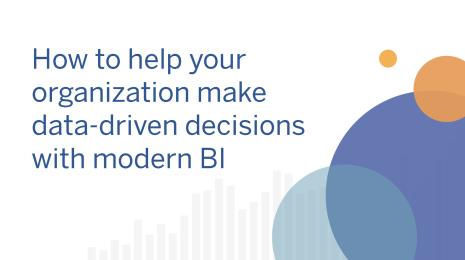The 5 phases of today’s analytic workflow

Originally published on CIO.com.
The transition to a self-service-based, modern business intelligence model requires IT to adopt a collaborative approach that includes the business in all aspects of the overall program.
This transition often involves choosing the right modern analytics platform. During this selection process, both the business and IT should assess each platform's ability to execute on the modern analytics workflow.
5 components of the modern analytics workflow
The modern analytic workflow is a cycle of five inter-related key areas, as shown below:
IT enables this workflow, but it is primarily driven by business users and analysts throughout the organization. And its successful implementation requires collaboration and participation from all roles.
In order to select a modern BI platform that can be adopted and widely deployed, organizations should consider the platform’s value for each phase of this workflow from the perspectives of the IT/BI professional, the content creator, and the information consumer.
1. Access and view
As organizations transition from a traditional top-down approach driven by IT to one based on self-service, it is often advantageous for IT to develop an initial set of trusted data sources and analytics content. Business users can then use this content as a starting point for analysis.
Your platform of choice should enable IT/BI professionals who manage a centralized environment of analytics content and data sources. It should also address the needs of information consumers who drives the specific usage requirements and parameters.
2. Interact
The interact phase is an extension of the initial access-and-view phase of the analytics workflow. It offers information consumers need to perform guided analysis of available content within predetermined fixed boundaries as set by the content publisher.
3. Analyze and discover
As users interact with dashboards and generate new questions, they will inevitably encounter barriers as they reach the limits of the guided experience offered by existing dashboards. When this occurs, users require a self-driven, autonomous framework for asking and answering new questions.
Users of all skill levels must be able to visualize as they analyze and access the analytics capabilities of the platform while in the flow of analysis without having to move to a different module or product in the suite.
The concepts of platform integration and ease of use are most critical to consider here. The transition from the “interact” phase to “analyze & discover” is often where the analytics workflow is disrupted due to lack of overall continuity of platform components needed to ask the next level of questions.
4. Share
The approach to sharing content has evolved. Within traditional BI platforms, sharing meant the delivery of static printed or exported reports to an inbox or a user’s desk.
Within the modern analytics approach, sharing now includes collaboration and aspects of social interactions that we have grown accustomed to with all of our business tools. This transition is driven by the simple fact that information is outdated as soon as the report is printed or exported. And this doesn’t align with the needs of today’s consumer seeking the latest information.
Some aspects of content sharing involve making information broadly available to users while others aspects entail collaboration as a core component of the analysis process. Consider both of these scenarios when evaluating your platform, especially from the perspectives of the IT/BI professional and the content creator.
5. Promote and govern
When choosing a modern analytics platform, flexibility is important to consider in order to meet the needs of the business and to ensure scalability. An organization may choose to facilitate the transition from traditional to modern by initially using the modern platform in a traditional manner then gradually expanding the range of capabilities that are accessible to users through self-service.
It is equally as important to evaluate a platform’s distinct capabilities in the separate but related areas of data governance and analytics governance. The tool should provide an adequate amount of flexibility to put the most appropriate governance model in place and adjust over time as needed.
Embrace governed self-service analytics at scale
The shift from traditional BI platforms to modern analytics platforms is one that is necessary to truly realize the impact data can have on an organization. Modern analytics platforms bring together self-service and governance to empower the entire organization with trusted data to gain insights into the business. These platforms should be evaluated through a different lens as they break the mold of traditional, IT-run BI platforms.
For a more detailed criteria, including a detailed questionnaire, check out our whitepaper, Evaluation Guide: How to choose the right modern BI & analytics platform.
Historias relacionadas
Suscribirse a nuestro blog
Obtenga las últimas actualizaciones de Tableau en su bandeja de entrada.








